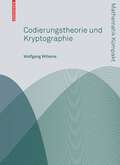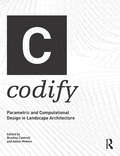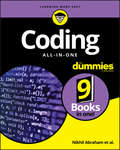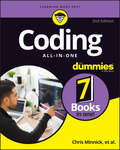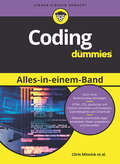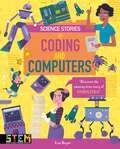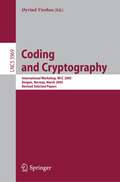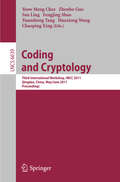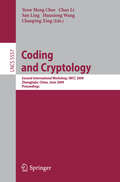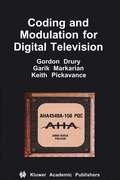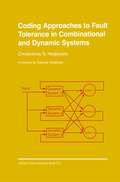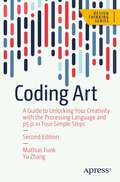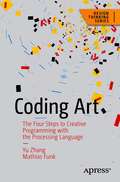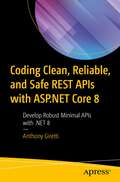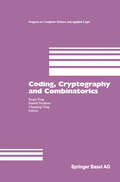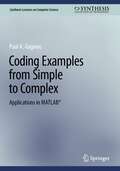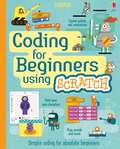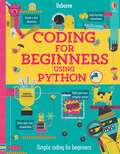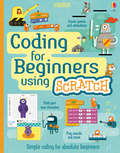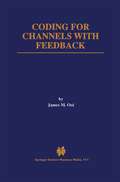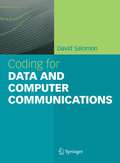- Table View
- List View
Codierungstheorie und Kryptographie (Mathematik Kompakt)
by Wolfgang WillemsIm heutigen Informationszeitalter werden ständig riesige Mengen digitaler Daten über verschiedene Kanäle übertragen. Codierungstheorie und Kryptographie sind Instrumente, um zentrale Probleme der Datenübertragung wie Übertragungsfehler und Datensicherheit zu lösen. Das Buch führt in die aktuellen Methoden der Codierungstheorie und Kryptographie ein und vermittelt notwendige Grundlagen der Algebra und der Algorithmen. Dabei werden LDPC-Codes und der AKS-Algorithmus ausführlich dargestellt. Der Anhang bietet zahlreiche Übungsaufgaben.
Codify: Parametric and Computational Design in Landscape Architecture
by Bradley Cantrell Adam MekiesCodify: Parametric and Computational Design in Landscape Architecture provides a series of essays that explore what it means to use, modify and create computational tools in a contemporary design environment. Landscape architecture has a long history of innovation in the areas of computation and media, particularly in how the discipline represents, analyses, and constructs complex systems. This curated volume spans academic and professional projects to form a snapshot of digital practices that aim to show how computation is a tool that goes beyond methods of representation and media. The book is organized in four sections; syntax, perception, employ, and prospective. The essays are written by leading academics and professionals and the sections examine the role of computational tools in landscape architecture through case studies, historical accounts, theoretical arguments, and nascent propositions.
Codify: Parametric and Computational Design in Landscape Architecture
by Bradley Cantrell Adam MekiesCodify: Parametric and Computational Design in Landscape Architecture provides a series of essays that explore what it means to use, modify and create computational tools in a contemporary design environment. Landscape architecture has a long history of innovation in the areas of computation and media, particularly in how the discipline represents, analyses, and constructs complex systems. This curated volume spans academic and professional projects to form a snapshot of digital practices that aim to show how computation is a tool that goes beyond methods of representation and media. The book is organized in four sections; syntax, perception, employ, and prospective. The essays are written by leading academics and professionals and the sections examine the role of computational tools in landscape architecture through case studies, historical accounts, theoretical arguments, and nascent propositions.
Coding All-in-One For Dummies
by Nikhil AbrahamSee all the things coding can accomplish The demand for people with coding know-how exceeds the number of people who understand the languages that power technology. Coding All-in-One For Dummies gives you an ideal place to start when you're ready to add this valuable asset to your professional repertoire. Whether you need to learn how coding works to build a web page or an application or see how coding drives the data revolution, this resource introduces the languages and processes you'll need to know. Peek inside to quickly learn the basics of simple web languages, then move on to start thinking like a professional coder and using languages that power big applications. Take a look inside for the steps to get started with updating a website, creating the next great mobile app, or exploring the world of data science. Whether you're looking for a complete beginner's guide or a trusted resource for when you encounter problems with coding, there's something for you! Create code for the web Get the tools to create a mobile app Discover languages that power data science See the future of coding with machine learning tools With the demand for skilled coders at an all-time high, Coding All-in-One For Dummies is here to propel coding newbies to the ranks of professional programmers.
Coding All-in-One For Dummies
by Nikhil AbrahamSee all the things coding can accomplish The demand for people with coding know-how exceeds the number of people who understand the languages that power technology. Coding All-in-One For Dummies gives you an ideal place to start when you're ready to add this valuable asset to your professional repertoire. Whether you need to learn how coding works to build a web page or an application or see how coding drives the data revolution, this resource introduces the languages and processes you'll need to know. Peek inside to quickly learn the basics of simple web languages, then move on to start thinking like a professional coder and using languages that power big applications. Take a look inside for the steps to get started with updating a website, creating the next great mobile app, or exploring the world of data science. Whether you're looking for a complete beginner's guide or a trusted resource for when you encounter problems with coding, there's something for you! Create code for the web Get the tools to create a mobile app Discover languages that power data science See the future of coding with machine learning tools With the demand for skilled coders at an all-time high, Coding All-in-One For Dummies is here to propel coding newbies to the ranks of professional programmers.
Coding All-in-One For Dummies
by Chris MinnickThe go-to guide for learning coding from the ground-up Adding some coding know-how to your skills can help launch a new career or bolster an old one. Coding All-in-One For Dummies offers an ideal starting place for learning the languages that make technology go. This edition gets you started with a helpful explanation of how coding works and how it’s applied in the real-world before setting you on a path toward writing code for web building, mobile application development, and data analysis. Add coding to your skillset for your existing career, or begin the exciting transition into life as a professional developer—Dummies makes it easy. Learn coding basics and how to apply them Analyze data and automate routine tasks on the job Get the foundation you need to launch a career as a coder Add HTML, JavaScript, and Python know-how to your resume This book serves up insight on the basics of coding, designed to be easy to follow, even if you’ve never written a line of code in your life. You can do this.
Coding All-in-One For Dummies
by Chris MinnickThe go-to guide for learning coding from the ground-up Adding some coding know-how to your skills can help launch a new career or bolster an old one. Coding All-in-One For Dummies offers an ideal starting place for learning the languages that make technology go. This edition gets you started with a helpful explanation of how coding works and how it’s applied in the real-world before setting you on a path toward writing code for web building, mobile application development, and data analysis. Add coding to your skillset for your existing career, or begin the exciting transition into life as a professional developer—Dummies makes it easy. Learn coding basics and how to apply them Analyze data and automate routine tasks on the job Get the foundation you need to launch a career as a coder Add HTML, JavaScript, and Python know-how to your resume This book serves up insight on the basics of coding, designed to be easy to follow, even if you’ve never written a line of code in your life. You can do this.
Coding Alles-in-einem-Band für Dummies (Für Dummies)
by Chris Minnick Nikhil Abraham Barry Burd Eva Holland Luca Massaron John Paul MuellerWenn Sie Webseiten oder mobile Apps entwickeln möchten, dann ist dieses Buch für Sie gemacht! Auch ganz ohne Vorkenntnisse steigen Sie einfach ein und lernen die einzelnen Programmiersprachen und Technologien jeweils für sich und im Zusammenspiel kennen und einsetzen. Angefangen beim grundlegenden Aufbau einer Webseite mit HTML, CSS und JavaScript über die Entwicklung mobiler Apps für iOS- und Android-Geräte mit Flutter bis hin zur Verarbeitung der Daten mit Python: Hier ist einfach mehr für Sie drin! Wenn Sie sich einen breiten Überblick über die Webentwicklung und Programmierung verschaffen wollen, dann werfen Sie am besten gleich einen Blick in dieses Buch ...
Coding and Computers: Discover the Amazing True Story of Computers! (Science Stories)
by Lisa ReganComputers are such an important part of our everyday lives... but how much do you really know about them? How does code work? Who invented the internet? This endlessly fascinating book not only explores the science behind information technology, but reveals the true-life stories of the people behind the scenes who played important roles in forging this radical transformation in human culture. It's absolutely packed with surprising and eye-opening facts, and a blast to read. A great gift for kids aged 8+.ABOUT THE SERIES: Science Stories is a vibrant educational series, focusing on the history of science and its major breakthroughs. Each title focuses on a different discipline - from computer science to the periodic table - brought to life by Roy Hermelin's full-colour illustrations.
Coding and Cryptography: International Workshop, WCC 2005, Bergen, Norway, March 14-18, 2005, Revised Selected Papers (Lecture Notes in Computer Science #3969)
by Øyvind YtrehusThis book constitutes the thoroughly refereed post-proceedings of the International Workshop on Coding and Cryptography, WCC 2005, held in Bergen, Norway, in March 2005. The 33 revised full papers were carefully reviewed and selected during two rounds of review. The papers address all aspects of coding theory, cryptography and related areas, theoretical or applied.
Coding and Cryptology: Third International Workshop, IWCC 2011, Qingdao, China, May 30-June 3, 2011. Proceedings (Lecture Notes in Computer Science #6639)
by Yeow Meng Chee Zhenbo Guo San Ling Fengjing Shao Yuansheng Tang Huaxiong Wang Chaoping XingThis book constitutes the refereed proceedings of the Third International Workshop on Coding and Cryptology, IWCC 2011, held in Qingdao, China, May 30-June 3, 2011. The 19 revised full technical papers are contributed by the invited speakers of the workshop. The papers were carefully reviewed and cover a broad range of foundational and methodological as well as applicative issues in coding and cryptology, as well as related areas such as combinatorics.
Coding and Cryptology: Second International Workshop, IWCC 2009 (Lecture Notes in Computer Science #5557)
by Yeow Meng Chee Chao Li San Ling Huaxiong Wang Chaoping XingThis book constitutes the refereed proceedings of the Second International Workshop on Coding and Cryptology, IWCC 2009, held in Zhangjiajie, China, in June 2009. The 21 revised full technical papers, except one, are contributed by the invited speakers of the workshop. The papers were carefully selected during two rounds of reviewing and improvement for inclusion in the volume and address all aspects of coding theory, cryptology and related areas - such as combinatorics - theoretical or applied. Topics addressed are coding theory, secure codes, hash functions, combinatorics, boolean functions, authentication, cryptography, protocols, sequences, and secure communications.
Coding and Modulation for Digital Television (Multimedia Systems and Applications #17)
by Gordon M. Drury Garik Markarian Keith PickavanceCoding and Modulation for Digital Television presents a comprehensive description of all error control coding and digital modulation techniques used in Digital Television (DTV). This book illustrates the relevant elements from the expansive theory of channel coding to how the transmission environment dictates the choice of error control coding and digital modulation schemes. These elements are presented in such a way that both the `mathematical integrity' and `understanding for engineers' are combined in a complete form and supported by a number of practical examples. In addition, the book contains descriptions of the existing standards and provides a valuable source of corresponding references. Coding and Modulation for Digital Television also features a description of the latest techniques, providing the reader with a glimpse of future digital broadcasting. These include the concepts of soft-in-soft-out decoding, turbo-coding and cross-correlated quadrature modulation, all of which will have a prominent future in improving efficiency of the next generation DTV systems. Coding and Modulation for Digital Television is essential reading for all undergraduate and postgraduate students, broadcasting and communication engineers, researchers, marketing managers, regulatory bodies, governmental organizations and standardization institutions of the digital television industry.
Coding Approaches to Fault Tolerance in Combinational and Dynamic Systems (The Springer International Series in Engineering and Computer Science #660)
by Christoforos N. HadjicostisCoding Approaches to Fault Tolerance in Combinational and Dynamic Systems describes coding approaches for designing fault-tolerant systems, i.e., systems that exhibit structured redundancy that enables them to distinguish between correct and incorrect results or between valid and invalid states. Since redundancy is expensive and counter-intuitive to the traditional notion of system design, the book focuses on resource-efficient methodologies that avoid excessive use of redundancy by exploiting the algorithmic/dynamic structure of a particular combinational or dynamic system. The first part of Coding Approaches to Fault Tolerance in Combinational and Dynamic Systems focuses on fault-tolerant combinational systems providing a review of von Neumann's classical work on Probabilistic Logics (including some more recent work on noisy gates) and describing the use of arithmetic coding and algorithm-based fault-tolerant schemes in algebraic settings. The second part of the book focuses on fault tolerance in dynamic systems. Coding Approaches to Fault Tolerance in Combinational and Dynamic Systems also discusses how, in a dynamic system setting, one can relax the traditional assumption that the error-correcting mechanism is fault-free by using distributed error correcting mechanisms. The final chapter presents a methodology for fault diagnosis in discrete event systems that are described by Petri net models; coding techniques are used to quickly detect and identify failures. From the Foreword: "Hadjicostis has significantly expanded the setting to processes occurring in more general algebraic and dynamic systems... The book responds to the growing need to handle faults in complex digital chips and complex networked systems, and to consider the effects of faults at the design stage rather than afterwards." George Verghese, Massachusetts Institute of Technology Coding Approaches to Fault Tolerance in Combinational and Dynamic Systems will be of interest to both researchers and practitioners in the area of fault tolerance, systems design and control.
Coding Art: A Guide to Unlocking Your Creativity with the Processing Language and p5.js in Four Simple Steps (Design Thinking)
by Mathias Funk Yu ZhangFinally, a book on creative programming, written directly for artists and designers! This second edition offers expanded and updated content incorporating the latest advancements and trends in the field of creative programming, also for creatives who want to work directly with P5.js and online. It delves deeper into the intricacies of computational art. It includes fresh case studies that explore real-world applications of coding art, inspiring readers to think beyond traditional boundaries.Rather than following a computer science curriculum, this book is aimed at creatives who are working in the intersection of design, art, and education. Following a real-world use case of computation art, you'll see how it relates back to the four key pillars, and addresses potential pitfalls and challenges in the creative process. All code examples are presented in a fully integrated Processing example library, making it easy for readers to get started. This unique and finely balanced approach between skill acquisition and development makes Coding Art, Second Edition the ideal reference book for both creative programming and the creative process for professors and students alike.What You’ll LearnReview ideas and approaches from creative programming to different professional domainsWork with computational tools like the Processing languageUnderstand the skills needed to move from static elements to animation to interactionUse interactivity as input to bring creative concepts closer to refinement and depthSimplify and extend the design of aesthetics, rhythms, and smoothness with data structuresLeverage the diversity of art code on other platforms like the web or mobile applicationsUnderstand the end-to-end process of computation art through real world use casesStudy best practices, common pitfalls, and challenges of the creative processWho This Book Is ForThose looking to see what computation and data can do for their creative expression; learners who want to integrate computation and data into their practices in different perspectives; creative technologists, educators, digital artists and those who already know how to program, seeking creativity and inspiration in the context of computation and data.
Coding Art: The Four Steps to Creative Programming with the Processing Language (Design Thinking)
by Yu Zhang Mathias FunkFinally, a book on creative programming, written directly for artists and designers! Rather than following a computer science curriculum, this book is aimed at creatives who are working in the intersection of design, art, and education. In this book you'll learn to apply computation into the creative process by following a four-step process, and through this, land in the cross section of coding and art, with a focus on practical examples and relevant work structures. You'll follow a real-world use case of computation art and see how it relates back to the four key pillars, and addresses potential pitfalls and challenges in the creative process. All code examples are presented in a fully integrated Processing example library, making it easy for readers to get started.This unique and finely balanced approach between skill acquisition and the creative process and development makes Coding Art a functional reference book for both creative programming and the creative process for professors and students alike.What You’ll LearnReview ideas and approaches from creative programming to different professional domainsWork with computational tools like the Processing languageUnderstand the skills needed to move from static elements to animation to interactionUse interactivity as input to bring creative concepts closer to refinement and depthSimplify and extend the design of aesthetics, rhythms, and smoothness with data structuresLeverage the diversity of art code on other platforms like the web or mobile applicationsUnderstand the end-to-end process of computation art through real world use casesStudy best practices, common pitfalls, and challenges of the creative processWho This Book Is ForThose looking to see what computation and data can do for their creative expression; learners who want to integrate computation and data into their practices in different perspectives; and those who already know how to program, seeking creativity and inspiration in the context of computation and data.
Coding Clean, Reliable, and Safe REST APIs with ASP.NET Core 8: Develop Robust Minimal APIs with .NET 8
by Anthony GirettiLearn ASP.NET Core APIs delivered in its latest version of the Microsoft Framework: .NET 8. This book will show you how to develop APIs with ASP.NET Core 8. Author Anthony Giretti will reveal all you need to know about HTTP protocol, REST architecture style, and ASP.NET Core 8. You will learn what reflexes and mindset a developer must have to approach the development of an API of medium complexity. By performing CRUD operations on a SQL Server database, you will see how to set up a clean and reliable application with industry best practices (clean code, security, observability, optimization and testing). After completing Coding Clean, Reliable, and Safe REST APIs with ASP.NET Core 8, you will be able to develop many kinds of APIs that require a senior developer level of knowledge and provide your customers with high-quality APIs. What You Will Learn Discover the latest version of ASP.NET Core 8Code REST APIs with minimal APIsBecome familiar with clean code principlesOptimize performances with caching, background tasks and moreMake APIs resilient by handling SQL and HttpClient transient errorsUnderstand the importance of observabilityImplement Authentication and AuthorizationGrasp OWASP principlesProtect sensitive dataMaster unit testing best practices Who This Book Is For Beginner and intermediate professionals wishing to build clean, reliable and safe ASP.NET Core APIs and elevate their skills to a senior developer level.
Coding Club Python: Interactive Adventures Level 2
by Chris RoffeyA unique series that provides a framework for teaching coding skills. Take your Python coding skills to the next level by reinforcing your programming knowledge from Python: Next Steps and learn a few more tricks with this Level 2 book. Python: Interactive Adventures offers full support for students who have some basic programming experience and are ready to move on to more challenging material. Activities include creating a simple eBook reader and a classic mystery game. The code is suitable for Mac, Windows and Linux users and is compatible with Raspberry Pi.
Coding, Cryptography and Combinatorics (Progress in Computer Science and Applied Logic #23)
by Keqin Feng Harald Niederreiter Chaoping XingIt has long been recognized that there are fascinating connections between cod ing theory, cryptology, and combinatorics. Therefore it seemed desirable to us to organize a conference that brings together experts from these three areas for a fruitful exchange of ideas. We decided on a venue in the Huang Shan (Yellow Mountain) region, one of the most scenic areas of China, so as to provide the additional inducement of an attractive location. The conference was planned for June 2003 with the official title Workshop on Coding, Cryptography and Combi natorics (CCC 2003). Those who are familiar with events in East Asia in the first half of 2003 can guess what happened in the end, namely the conference had to be cancelled in the interest of the health of the participants. The SARS epidemic posed too serious a threat. At the time of the cancellation, the organization of the conference was at an advanced stage: all invited speakers had been selected and all abstracts of contributed talks had been screened by the program committee. Thus, it was de cided to call on all invited speakers and presenters of accepted contributed talks to submit their manuscripts for publication in the present volume. Altogether, 39 submissions were received and subjected to another round of refereeing. After care ful scrutiny, 28 papers were accepted for publication.
Coding Examples from Simple to Complex: Applications in MATLAB® (Synthesis Lectures on Computer Science)
by Paul A. GagniucThis book provides a comprehensive guide to Matlab, which stands as the cornerstone of modern education and is the main computer language driving development in science and engineering. The author introduces readers to the rich world of Matlab, taking them on a journey from the fundamentals to advanced topics, equipping them with the knowledge and skills needed to become a proficient Matlab developer or scientist. The book provides a treasure trove of practical examples, meticulously crafted to deepen the reader understanding of Matlab. This comprehensive exploration is designed to cater to novice learners as well as mature developers and scientists, equipping them with the requisite knowledge and competencies to harness the Matlab full potential in their respective projects. From the basics of variable naming and program structure to complex matrix operations, recursion, and object-oriented programming, this book covers it all. This book is part of a series of worksdesigned to present both the examples and their explanations in various computer languages, as close to a mirror version as possible.
Coding For Beginners: Using Scratch (PDF)
by Johnathan Melmouth Rosie DickinsAn introduction to coding for complete beginners, this friendly and accessible book will teach children the basics of Scratch (a free, online programme developed by MIT which is widely used in primary schools), allowing them to get inside the code of their computer and create simple games and animations on screen.
Coding for Beginners: Using Python
by Louie StowellA beginner’s guide to coding using Python, one of the most popular computer languages. Step-by-step instructions show how to get started and write a simple program. New commands are introduced with examples and colourful pictures so by the end of the book, readers can code games, drawings and more. Includes extra help and downloads online. 9781409599340
Coding For Beginners - Using Scratch
by Rosie Dickins Shaw NielsenAn introduction to coding for complete beginners, this friendly and accessible book teaches children the basics of Scratch (a free, online programme developed by MIT which is widely used in primary schools), allowing them to get inside the code of their computer and create simple games and animations on screen.
Coding for Channels with Feedback (The Springer International Series in Engineering and Computer Science #452)
by James M. OoiCoding for Channels with Feedback presents both algorithms for feedback coding and performance analyses of these algorithms, including analyses of perhaps the most important performance criterion: computational complexity. The algorithms are developed within a single framework, termed the compressed-error-cancellation framework, where data are sent via a sequence of messages: the first message contains the original data; each subsequent message contains a source-coded description of the channel distortions introduced on the message preceding it. Coding for Channels with Feedback provides an easily understood and flexible framework for deriving low-complexity, practical solutions to a wide variety of feedback communication problems. It is shown that the compressed-error-cancellation framework leads to coding schemes with the lowest possible asymptotic order of growth of computations and can be applied to discrete memoryless channels, finite state channels, channels with memory, unknown channels, and multiple-access channels, all with complete noiseless feedback, as well as to channels with partial and noisy feedback. This framework leads to coding strategies that have linear complexity and are capacity achieving, and illustrates the intimate connection between source coding theory and channel coding theory. Coding for Channels with Feedback is an excellent reference for researchers and communication engineers in the field of information theory, and can be used for advanced courses on the topic.
Coding for Data and Computer Communications
by David SalomonDetails the most important techniques used to make the storage and transmission of data fast, secure, and reliable. Accessible to both specialists and nonspecialists: Avoids complex mathematics
